Unit 6 Do you like bananas? 教案(共5课时) 2024-2025学年人教版七年级英语上册
文档属性
| 名称 | Unit 6 Do you like bananas? 教案(共5课时) 2024-2025学年人教版七年级英语上册 | 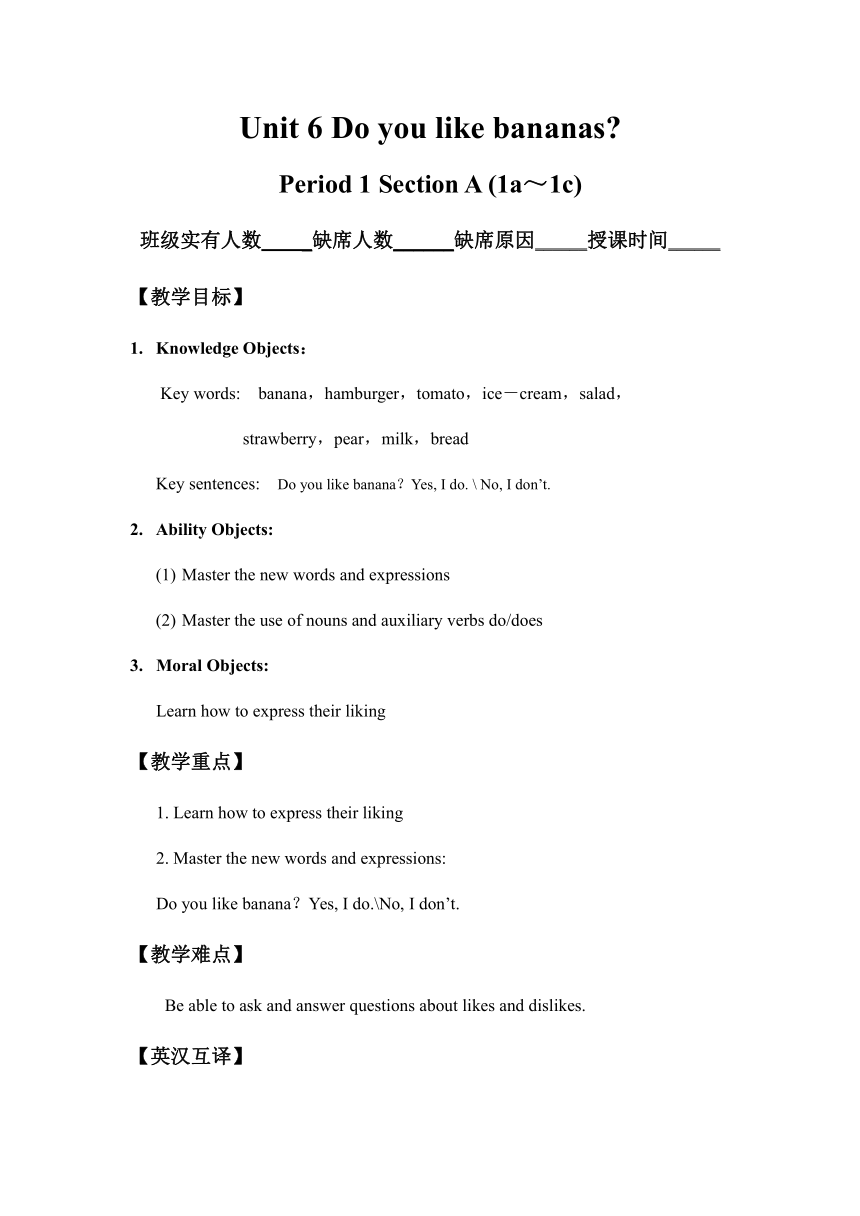 | |
| 格式 | docx | ||
| 文件大小 | 161.5KB | ||
| 资源类型 | 教案 | ||
| 版本资源 | 人教新目标(Go for it)版 | ||
| 科目 | 英语 | ||
| 更新时间 | 2024-06-16 20:28:25 | ||
图片预览

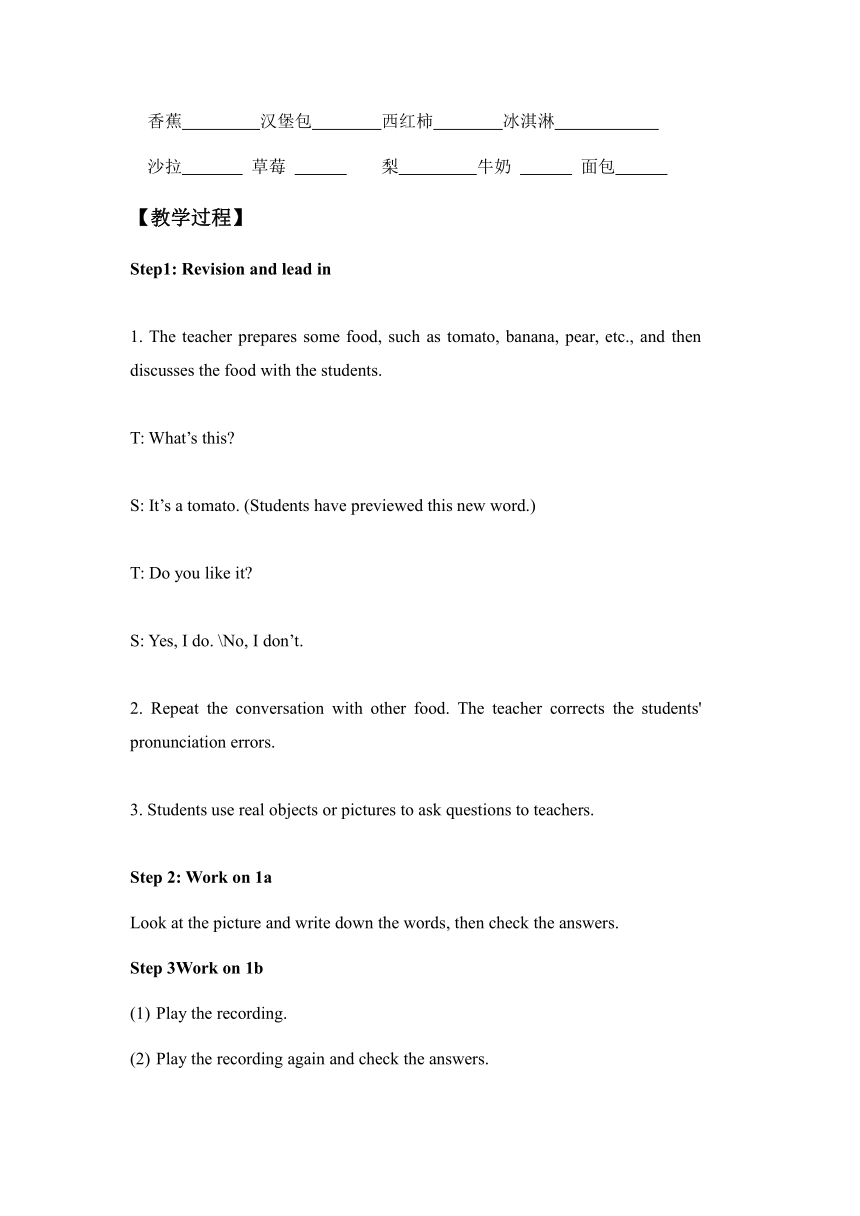
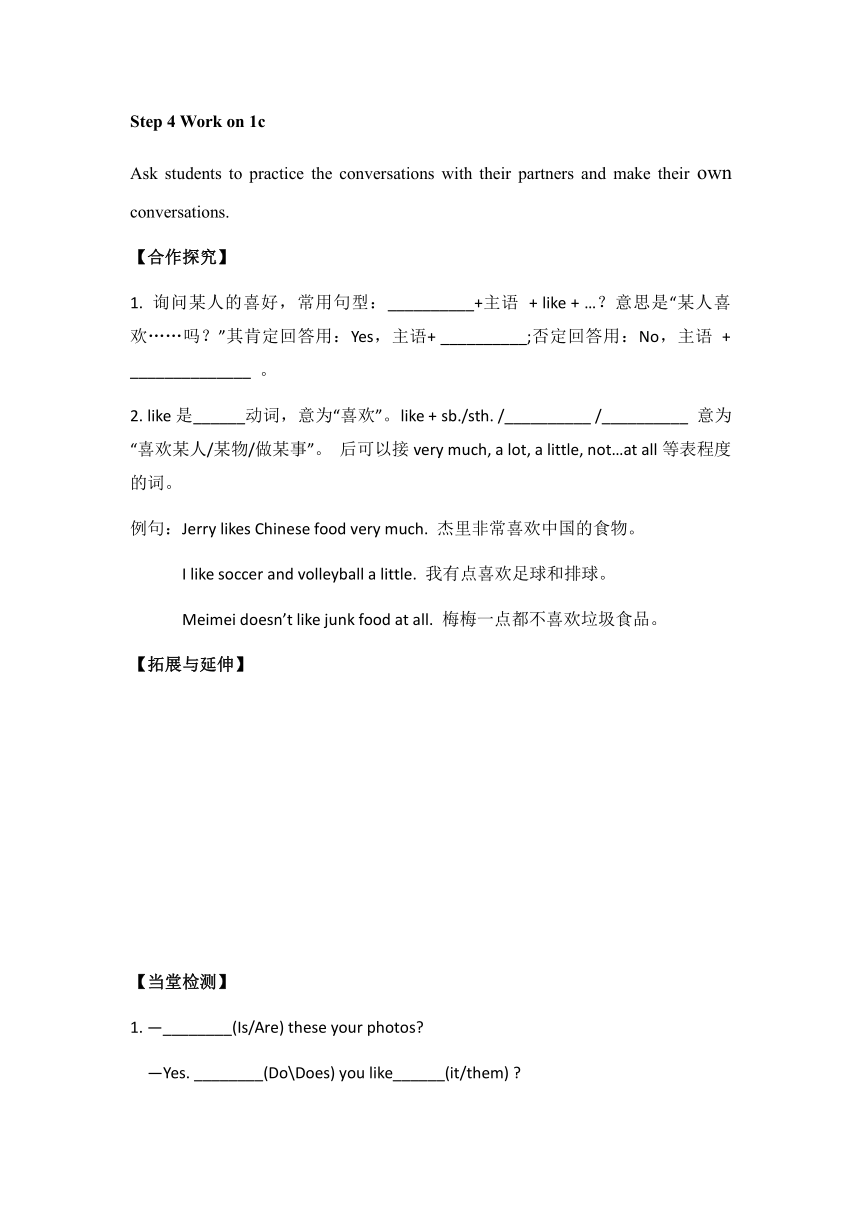
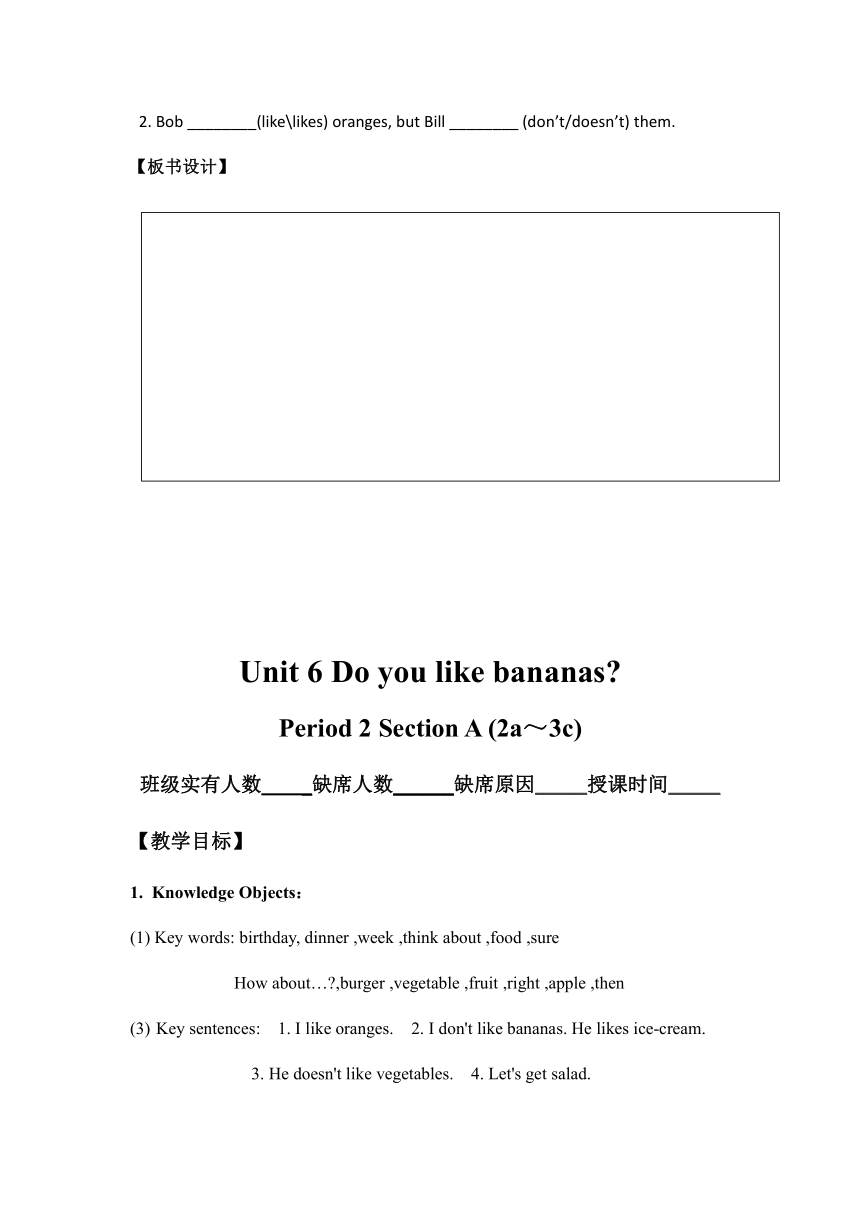
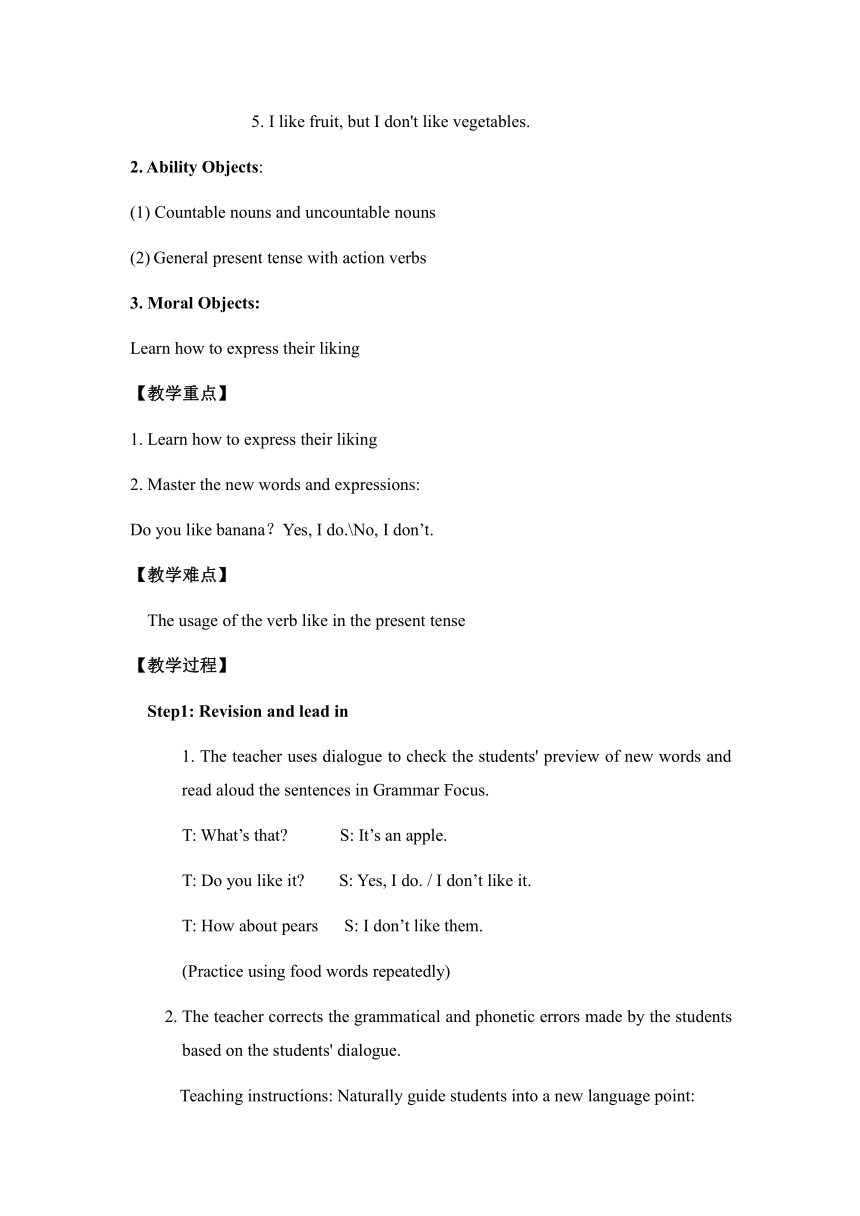
文档简介
Unit 6 Do you like bananas
Period 1 Section A (1a~1c)
班级实有人数 _缺席人数______缺席原因______授课时间______
【教学目标】
Knowledge Objects:
Key words: banana,hamburger,tomato,ice-cream,salad,
strawberry,pear,milk,bread
Key sentences: Do you like banana?Yes, I do. \ No, I don’t.
Ability Objects:
Master the new words and expressions
Master the use of nouns and auxiliary verbs do/does
Moral Objects:
Learn how to express their liking
【教学重点】
1. Learn how to express their liking
2. Master the new words and expressions:
Do you like banana?Yes, I do.\No, I don’t.
【教学难点】
Be able to ask and answer questions about likes and dislikes.
【英汉互译】
香蕉 汉堡包 西红柿 冰淇淋
沙拉 草莓 梨 牛奶 面包
【教学过程】
Step1: Revision and lead in
1. The teacher prepares some food, such as tomato, banana, pear, etc., and then discusses the food with the students.
T: What’s this
S: It’s a tomato. (Students have previewed this new word.)
T: Do you like it
S: Yes, I do. \No, I don’t.
2. Repeat the conversation with other food. The teacher corrects the students' pronunciation errors.
3. Students use real objects or pictures to ask questions to teachers.
Step 2: Work on 1a
Look at the picture and write down the words, then check the answers.
Step 3Work on 1b
Play the recording.
Play the recording again and check the answers.
Step 4 Work on 1c
Ask students to practice the conversations with their partners and make their own conversations.
【合作探究】
1. 询问某人的喜好,常用句型:__________+主语 + like + …?意思是“某人喜欢……吗?”其肯定回答用:Yes,主语+ __________;否定回答用:No,主语 + ______________ 。
2. like是______动词,意为“喜欢”。like + sb./sth. /__________ /__________ 意为“喜欢某人/某物/做某事”。 后可以接very much, a lot, a little, not…at all等表程度的词。
例句:Jerry likes Chinese food very much. 杰里非常喜欢中国的食物。
I like soccer and volleyball a little. 我有点喜欢足球和排球。
Meimei doesn’t like junk food at all. 梅梅一点都不喜欢垃圾食品。
【拓展与延伸】
【当堂检测】
1. —________(Is/Are) these your photos
—Yes. ________(Do\Does) you like______(it/them)
2. Bob ________(like\likes) oranges, but Bill ________ (don’t/doesn’t) them.
【板书设计】
Unit 6 Do you like bananas
Period 2 Section A (2a~3c)
班级实有人数 _缺席人数______缺席原因______授课时间______
【教学目标】
Knowledge Objects:
(1) Key words: birthday, dinner ,week ,think about ,food ,sure
How about… ,burger ,vegetable ,fruit ,right ,apple ,then
Key sentences: 1. I like oranges. 2. I don't like bananas. He likes ice-cream.
3. He doesn't like vegetables. 4. Let's get salad.
5. I like fruit, but I don't like vegetables.
2. Ability Objects:
(1) Countable nouns and uncountable nouns
(2) General present tense with action verbs
3. Moral Objects:
Learn how to express their liking
【教学重点】
1. Learn how to express their liking
2. Master the new words and expressions:
Do you like banana?Yes, I do.\No, I don’t.
【教学难点】
The usage of the verb like in the present tense
【教学过程】
Step1: Revision and lead in
1. The teacher uses dialogue to check the students' preview of new words and read aloud the sentences in Grammar Focus.
T: What’s that S: It’s an apple.
T: Do you like it S: Yes, I do. / I don’t like it.
T: How about pears S: I don’t like them.
(Practice using food words repeatedly)
2. The teacher corrects the grammatical and phonetic errors made by the students based on the students' dialogue.
Teaching instructions: Naturally guide students into a new language point:
Do you like... I don’t like...
Step 2: Work on 2a and 2b and practice the conversations follow
(1) Listen to the conversations
(2) Check the answers
(3) Listen and circle the names
(4) Practice the conversations
(5) Give answers that are true for you.
Step 3 :Work on 2d
(1)Role-play
Read the conversation in 2d and role-play it with your partner in front of the class.
(2)Pair work
Show students a few pictures of discuss what to eat for birthday and ask them to talk about like or dislike.
Step4: Students read aloud the sentences in Grammar
and complete the 3a task independently
Review the positive and negative forms of like; the third-person singular
and non-singular three-person forms of like.
Step5: Quickly complete the 3b task
And the teacher checks the answers.
Step6: Group work
Take a survey as a group, and use the Do you like... sentence pattern to ask the group members about the food in the 3c form, and complete the form. Then each group selects a student as a representative to report the survey results. (The purpose is to consolidate Do you like... I don't like...He/ She likes...He/ She doesn't like... sentence patterns and strengthen the memory of food nouns.)
【合作探究】
1.行为动词的一般现在时结构
行为动词在肯定句、否定句、一般疑问句中的用法及其答语(以like为例)如下表:
例句:I like ice-cream. 我喜欢冰激凌。
She______ English. 她喜欢英语。
She ________ English. 她不喜欢英语。
—______ she ______ English 她喜欢英语吗?
—Yes, she______. 是的,她喜欢。/No, she ________. 不,她不喜欢。
2.可数名词和不可数名词
提示:在英语中,有些名词既是可数名词,又是不可数名词,但所表达的意义不同。如:______水果,_________各种水果;______鸡肉,________小鸡。
规则变化口诀
单数名词变复数,多数直接加____;s,x,ch,sh来结尾,直接加上____;
词尾若是f或fe,变成____加____;辅音+y在词尾,____改____加______;
词尾字母若是o,常用三个已足够,英雄土豆西红柿(______________),要加____请记好。
【拓展与延伸】
【当堂检测】
一、用所给词的适当形式填空
1. She likes__________(strawberry).
2. It is quite fine today! How about________(go) climbing this afternoon
3. Does she like________(bread)
4. Do you like________(pear)
5. My sister________(have) ice cream for supper.
【板书设计】
Unit 6 Do you like bananas
Period 3 Section B (1a~1e)
班级实有人数 _缺席人数______缺席原因______授课时间______
【教学目标】
1.Knowledge Objects:
Key words: breakfast, lunch
Key sentences: —Does Tom like carrots
—Yes, he does.
2.Ability Objects:
(1) Countable nouns and uncountable nouns
(2) General present tense with action verbs
3.Moral Objects:
Learn how to express their liking
【教学重点】
1. Learn how to express their liking
2. Master the new words and expressions:
—Does Tom like carrots
—Yes, he does.
【教学难点】
The usage of the verb like in the present tense
【教学过程】
Step 1:Lead-in:
. The teacher introduces his food preferences and three meals.
T: I like eggs, chicken, vegetables, tomatoes. I don’t like salad, carrots or pears. I have eggs and milk for breakfast and have rice, chicken and vegetable for lunch. I have tomatoes and eggs for dinner.
2. The teacher encourages students to introduce their favorite and dislike foods, as well as the three meals.
Step2: Teaching 1a.
1.Students read the words in 1a, preferably silently.
2. Write the word number in 1a next to the corresponding food.
Step3: Teaching 1b.
Ask students to divide the words of the food they learn into fruits and vegetables.
Step4: Teaching 1c.
Listen to the recording of 1c and circle the food you hear in 1a.
Step5: Teaching 1d.
Listen to the recording again and fill in the form in 1d..Listen to the recording and follow along.students to ask questions based on the information in Table 1d.Students ask questions based on their actual situation and perform their own dialogues.The teacher shows pictures of food for students to have a conversation in pairs.
【合作探究】
1. salad的用法
(1)若强调这种物质,为不可数名词,意为“________”。
(2)若指“一份沙拉”或“一盘沙拉”,则为__________。
例句: _________________. 我吃沙拉/一份沙拉。
【拓展】ice-cream用法与其类似,若强调该物质,则为______名词; 若指数量,则为______名词。
例句: ___________________ 让我们吃一些冰激凌。
____________________ 请给我两份冰激凌。
2. breakfast, lunch和dinner
breakfast意为“______”,lunch意为“______”,dinner意为“____________”。
常用短语:
(1)___________________吃早/午/晚餐
(2)___________________早/午/晚/餐吃……
3. 可数名词和不可数名词的修饰词
(1)可数名词可以被__________、__________和__________(如:few, a few, many, some, any, a lot of 等)修饰。
(2)不可数名词不能用__________及指示代词修饰, 不能用基数词修饰。可以用some, any, a little, much, a lot of等修饰。
【拓展延伸】
【当堂检测】
填单词完成对话。
A: ______you like fruit?
B:Yes, I do.
A: __________about vegetables salad?
B:No, I ________ like vegetables. Well, only salad.
A: What about your brother
B:He ______ ice-cream.
【板书设计】
Unit 6 Do you like bananas
Period 4 Section B (2a-2c)
班级实有人数 _缺席人数______缺席原因______授课时间______
【教学目标】
1.Knowledge Object:
Key words: star, eat, well, habit, healthy, really, question, want, be, fat , sports star, eat well, eating habits, ask sb. about sth. , one last question
Key sentences: 1. Sports star eats well.
2. What do you like for breakfast
3. I don’t want to be fat.
2.Ability Object:
(1) Countable nouns and uncountable nouns
(2) General present tense with action verbs
3.Moral Object:
Learn how to express their liking
【教学重点】
1. Learn how to express their liking
2. Master the new words and expressions:
1. Sports star eats well.
2. What do you like for breakfast
3. I don’t want to be fat.
【教学难点】
The usage of the verb like in the present tense
【教学过程】
Step 1:Lead-in:
Teachers guide students into new language knowledge through dialogue.
T: Do you have vegetables for lunch
S: No, I don’t.
T: What do you have for lunch
S: I have/eat hamburgers.
T: You don’t eat well. So you are not healthy.
S: But I like hamburgers.
Step2: Read the food word in 2a
Then complete the form in 2a. (Which food do you think is healthy
Tick Yes, Maybe or No.)
Step3: Quickly read the 2b essay and circle the name of the food in it
Read the 2b article and answer the following questions.
(1) What does David ask Cindy about
(2) What does Cindy have for breakfast
(3) What does Cindy like for dinner
(4) Does Cindy eat ice-cream
Step4: Play the recording
Let the students listen to the 2b essay several times, and then follow it.
Step5: Encourage students to perform 2b dialogue
Step6: The student completes the task of 2c
Write five sentences and talk about Cindy's eating habits.
【合作探究】
1. Sports Star Eats Well!体育明星吃得好!
(1)star为可数名词,此处意为“明星”。也可作“星星”讲。
例句:_________________ 她是一位电影明星。
(2)sports star是名词短语,意为“体育明星,运动明星”。sports作定语修饰名词时,常用复数形式。
例如:__________ 运动鞋__________ 运动场__________ 运动会
( 3 )eat是动词,意为“吃”。其后接具体的食物名称。通常也可以用have 表示“吃(一日三餐); 喝”。
例句: ______________________ 我通常在家吃早餐。
(4)well是副词,意为“好”。用于实义动词后,表示“……得好”。
例句: ______________________ 你认为他唱得好吗?
【拓展与延伸】
【当堂检测】
1. He plays soccer ________(好).
2. Jim has a bad(坏的)________(吃)habit.
3. He want ______ ______(成为)a teacher(老师).
4. ________ ________ ____ ________(他喜欢什么)for lunch
【板书设计】
Unit 6 Do you like bananas
Period 5 Section B (3a-Self Check)
班级实有人数 _缺席人数______缺席原因______授课时间______
【教学目标】
1.Knowledge Objects:
(1)Go on learning the general questions beginning with do or does and the answers.
(2) Go on don’t like or doesn’t like in the negative sentences.
2.Ability Objects:
Get Ss to use like or likes, don’t like or doesn’t like to write a short passage in the real situation.
3.Moral Objects:
(1) To make the students be interested in cooperation and competition.
(2) To make the students love fruit and vegetables.
【教学重点】
(1) Consolidate the usage of have in the negative and general questions.
(2) Develop Ss' abilities of writing.
【教学难点】
Guide Ss to write with have in the negative and general questions.
【教学过程】
Step 1: Warming-up
(1) Greet the Ss, Check the homework. (Show the chart on the screen.)
(2) Review the words.
Step 2: Writing
(1) Let's work on 3a. This is a survey chart. You have to write some more questions about eating habits in the chart. Using the sentence structure Do you like... "
(2) Ss write three or more questions about eating habits.
Step3: Survey
Now exchange books with your partner. Answer his or her questions in 3a.
You can only check the answers.
Step4: Writing
(1) Look at the information in 3a. Write about yourself and your partner with but
(2) Ss read the sentences and try to write their own sentences according to 3a.
(3) Ss write their own sentences then report their sentences to their partner.
Step 5: Self Check
Let's work on Self Check. First Ss list all the sports they know.
Then discuss with their partner and write what they think of them.
3) Look at the chart. Here are some short conversations, but the questions are missing. Read the answers then think about the questions. Then write their own sentences.
Step 6. Writing
Write a short passage to introduce your eating habits.
__________________________________________________________________________________________________________________________________________
_____________________________________________________________________
_____________________________________________________________________
_____________________________________________________________________
_____________________________________________________________________
【板书设计】
【教学反思】
_____________________________________________________________________
_____________________________________________________________________
_____________________________________________________________________
_____________________________________________________________________
_____________________________________________________________________
_____________________________________________________________________
_____________________________________________________________________
_____________________________________________________________________
Step7: Writing
【教学反思】
Period 1 Section A (1a~1c)
班级实有人数 _缺席人数______缺席原因______授课时间______
【教学目标】
Knowledge Objects:
Key words: banana,hamburger,tomato,ice-cream,salad,
strawberry,pear,milk,bread
Key sentences: Do you like banana?Yes, I do. \ No, I don’t.
Ability Objects:
Master the new words and expressions
Master the use of nouns and auxiliary verbs do/does
Moral Objects:
Learn how to express their liking
【教学重点】
1. Learn how to express their liking
2. Master the new words and expressions:
Do you like banana?Yes, I do.\No, I don’t.
【教学难点】
Be able to ask and answer questions about likes and dislikes.
【英汉互译】
香蕉 汉堡包 西红柿 冰淇淋
沙拉 草莓 梨 牛奶 面包
【教学过程】
Step1: Revision and lead in
1. The teacher prepares some food, such as tomato, banana, pear, etc., and then discusses the food with the students.
T: What’s this
S: It’s a tomato. (Students have previewed this new word.)
T: Do you like it
S: Yes, I do. \No, I don’t.
2. Repeat the conversation with other food. The teacher corrects the students' pronunciation errors.
3. Students use real objects or pictures to ask questions to teachers.
Step 2: Work on 1a
Look at the picture and write down the words, then check the answers.
Step 3Work on 1b
Play the recording.
Play the recording again and check the answers.
Step 4 Work on 1c
Ask students to practice the conversations with their partners and make their own conversations.
【合作探究】
1. 询问某人的喜好,常用句型:__________+主语 + like + …?意思是“某人喜欢……吗?”其肯定回答用:Yes,主语+ __________;否定回答用:No,主语 + ______________ 。
2. like是______动词,意为“喜欢”。like + sb./sth. /__________ /__________ 意为“喜欢某人/某物/做某事”。 后可以接very much, a lot, a little, not…at all等表程度的词。
例句:Jerry likes Chinese food very much. 杰里非常喜欢中国的食物。
I like soccer and volleyball a little. 我有点喜欢足球和排球。
Meimei doesn’t like junk food at all. 梅梅一点都不喜欢垃圾食品。
【拓展与延伸】
【当堂检测】
1. —________(Is/Are) these your photos
—Yes. ________(Do\Does) you like______(it/them)
2. Bob ________(like\likes) oranges, but Bill ________ (don’t/doesn’t) them.
【板书设计】
Unit 6 Do you like bananas
Period 2 Section A (2a~3c)
班级实有人数 _缺席人数______缺席原因______授课时间______
【教学目标】
Knowledge Objects:
(1) Key words: birthday, dinner ,week ,think about ,food ,sure
How about… ,burger ,vegetable ,fruit ,right ,apple ,then
Key sentences: 1. I like oranges. 2. I don't like bananas. He likes ice-cream.
3. He doesn't like vegetables. 4. Let's get salad.
5. I like fruit, but I don't like vegetables.
2. Ability Objects:
(1) Countable nouns and uncountable nouns
(2) General present tense with action verbs
3. Moral Objects:
Learn how to express their liking
【教学重点】
1. Learn how to express their liking
2. Master the new words and expressions:
Do you like banana?Yes, I do.\No, I don’t.
【教学难点】
The usage of the verb like in the present tense
【教学过程】
Step1: Revision and lead in
1. The teacher uses dialogue to check the students' preview of new words and read aloud the sentences in Grammar Focus.
T: What’s that S: It’s an apple.
T: Do you like it S: Yes, I do. / I don’t like it.
T: How about pears S: I don’t like them.
(Practice using food words repeatedly)
2. The teacher corrects the grammatical and phonetic errors made by the students based on the students' dialogue.
Teaching instructions: Naturally guide students into a new language point:
Do you like... I don’t like...
Step 2: Work on 2a and 2b and practice the conversations follow
(1) Listen to the conversations
(2) Check the answers
(3) Listen and circle the names
(4) Practice the conversations
(5) Give answers that are true for you.
Step 3 :Work on 2d
(1)Role-play
Read the conversation in 2d and role-play it with your partner in front of the class.
(2)Pair work
Show students a few pictures of discuss what to eat for birthday and ask them to talk about like or dislike.
Step4: Students read aloud the sentences in Grammar
and complete the 3a task independently
Review the positive and negative forms of like; the third-person singular
and non-singular three-person forms of like.
Step5: Quickly complete the 3b task
And the teacher checks the answers.
Step6: Group work
Take a survey as a group, and use the Do you like... sentence pattern to ask the group members about the food in the 3c form, and complete the form. Then each group selects a student as a representative to report the survey results. (The purpose is to consolidate Do you like... I don't like...He/ She likes...He/ She doesn't like... sentence patterns and strengthen the memory of food nouns.)
【合作探究】
1.行为动词的一般现在时结构
行为动词在肯定句、否定句、一般疑问句中的用法及其答语(以like为例)如下表:
例句:I like ice-cream. 我喜欢冰激凌。
She______ English. 她喜欢英语。
She ________ English. 她不喜欢英语。
—______ she ______ English 她喜欢英语吗?
—Yes, she______. 是的,她喜欢。/No, she ________. 不,她不喜欢。
2.可数名词和不可数名词
提示:在英语中,有些名词既是可数名词,又是不可数名词,但所表达的意义不同。如:______水果,_________各种水果;______鸡肉,________小鸡。
规则变化口诀
单数名词变复数,多数直接加____;s,x,ch,sh来结尾,直接加上____;
词尾若是f或fe,变成____加____;辅音+y在词尾,____改____加______;
词尾字母若是o,常用三个已足够,英雄土豆西红柿(______________),要加____请记好。
【拓展与延伸】
【当堂检测】
一、用所给词的适当形式填空
1. She likes__________(strawberry).
2. It is quite fine today! How about________(go) climbing this afternoon
3. Does she like________(bread)
4. Do you like________(pear)
5. My sister________(have) ice cream for supper.
【板书设计】
Unit 6 Do you like bananas
Period 3 Section B (1a~1e)
班级实有人数 _缺席人数______缺席原因______授课时间______
【教学目标】
1.Knowledge Objects:
Key words: breakfast, lunch
Key sentences: —Does Tom like carrots
—Yes, he does.
2.Ability Objects:
(1) Countable nouns and uncountable nouns
(2) General present tense with action verbs
3.Moral Objects:
Learn how to express their liking
【教学重点】
1. Learn how to express their liking
2. Master the new words and expressions:
—Does Tom like carrots
—Yes, he does.
【教学难点】
The usage of the verb like in the present tense
【教学过程】
Step 1:Lead-in:
. The teacher introduces his food preferences and three meals.
T: I like eggs, chicken, vegetables, tomatoes. I don’t like salad, carrots or pears. I have eggs and milk for breakfast and have rice, chicken and vegetable for lunch. I have tomatoes and eggs for dinner.
2. The teacher encourages students to introduce their favorite and dislike foods, as well as the three meals.
Step2: Teaching 1a.
1.Students read the words in 1a, preferably silently.
2. Write the word number in 1a next to the corresponding food.
Step3: Teaching 1b.
Ask students to divide the words of the food they learn into fruits and vegetables.
Step4: Teaching 1c.
Listen to the recording of 1c and circle the food you hear in 1a.
Step5: Teaching 1d.
Listen to the recording again and fill in the form in 1d..Listen to the recording and follow along.students to ask questions based on the information in Table 1d.Students ask questions based on their actual situation and perform their own dialogues.The teacher shows pictures of food for students to have a conversation in pairs.
【合作探究】
1. salad的用法
(1)若强调这种物质,为不可数名词,意为“________”。
(2)若指“一份沙拉”或“一盘沙拉”,则为__________。
例句: _________________. 我吃沙拉/一份沙拉。
【拓展】ice-cream用法与其类似,若强调该物质,则为______名词; 若指数量,则为______名词。
例句: ___________________ 让我们吃一些冰激凌。
____________________ 请给我两份冰激凌。
2. breakfast, lunch和dinner
breakfast意为“______”,lunch意为“______”,dinner意为“____________”。
常用短语:
(1)___________________吃早/午/晚餐
(2)___________________早/午/晚/餐吃……
3. 可数名词和不可数名词的修饰词
(1)可数名词可以被__________、__________和__________(如:few, a few, many, some, any, a lot of 等)修饰。
(2)不可数名词不能用__________及指示代词修饰, 不能用基数词修饰。可以用some, any, a little, much, a lot of等修饰。
【拓展延伸】
【当堂检测】
填单词完成对话。
A: ______you like fruit?
B:Yes, I do.
A: __________about vegetables salad?
B:No, I ________ like vegetables. Well, only salad.
A: What about your brother
B:He ______ ice-cream.
【板书设计】
Unit 6 Do you like bananas
Period 4 Section B (2a-2c)
班级实有人数 _缺席人数______缺席原因______授课时间______
【教学目标】
1.Knowledge Object:
Key words: star, eat, well, habit, healthy, really, question, want, be, fat , sports star, eat well, eating habits, ask sb. about sth. , one last question
Key sentences: 1. Sports star eats well.
2. What do you like for breakfast
3. I don’t want to be fat.
2.Ability Object:
(1) Countable nouns and uncountable nouns
(2) General present tense with action verbs
3.Moral Object:
Learn how to express their liking
【教学重点】
1. Learn how to express their liking
2. Master the new words and expressions:
1. Sports star eats well.
2. What do you like for breakfast
3. I don’t want to be fat.
【教学难点】
The usage of the verb like in the present tense
【教学过程】
Step 1:Lead-in:
Teachers guide students into new language knowledge through dialogue.
T: Do you have vegetables for lunch
S: No, I don’t.
T: What do you have for lunch
S: I have/eat hamburgers.
T: You don’t eat well. So you are not healthy.
S: But I like hamburgers.
Step2: Read the food word in 2a
Then complete the form in 2a. (Which food do you think is healthy
Tick Yes, Maybe or No.)
Step3: Quickly read the 2b essay and circle the name of the food in it
Read the 2b article and answer the following questions.
(1) What does David ask Cindy about
(2) What does Cindy have for breakfast
(3) What does Cindy like for dinner
(4) Does Cindy eat ice-cream
Step4: Play the recording
Let the students listen to the 2b essay several times, and then follow it.
Step5: Encourage students to perform 2b dialogue
Step6: The student completes the task of 2c
Write five sentences and talk about Cindy's eating habits.
【合作探究】
1. Sports Star Eats Well!体育明星吃得好!
(1)star为可数名词,此处意为“明星”。也可作“星星”讲。
例句:_________________ 她是一位电影明星。
(2)sports star是名词短语,意为“体育明星,运动明星”。sports作定语修饰名词时,常用复数形式。
例如:__________ 运动鞋__________ 运动场__________ 运动会
( 3 )eat是动词,意为“吃”。其后接具体的食物名称。通常也可以用have 表示“吃(一日三餐); 喝”。
例句: ______________________ 我通常在家吃早餐。
(4)well是副词,意为“好”。用于实义动词后,表示“……得好”。
例句: ______________________ 你认为他唱得好吗?
【拓展与延伸】
【当堂检测】
1. He plays soccer ________(好).
2. Jim has a bad(坏的)________(吃)habit.
3. He want ______ ______(成为)a teacher(老师).
4. ________ ________ ____ ________(他喜欢什么)for lunch
【板书设计】
Unit 6 Do you like bananas
Period 5 Section B (3a-Self Check)
班级实有人数 _缺席人数______缺席原因______授课时间______
【教学目标】
1.Knowledge Objects:
(1)Go on learning the general questions beginning with do or does and the answers.
(2) Go on don’t like or doesn’t like in the negative sentences.
2.Ability Objects:
Get Ss to use like or likes, don’t like or doesn’t like to write a short passage in the real situation.
3.Moral Objects:
(1) To make the students be interested in cooperation and competition.
(2) To make the students love fruit and vegetables.
【教学重点】
(1) Consolidate the usage of have in the negative and general questions.
(2) Develop Ss' abilities of writing.
【教学难点】
Guide Ss to write with have in the negative and general questions.
【教学过程】
Step 1: Warming-up
(1) Greet the Ss, Check the homework. (Show the chart on the screen.)
(2) Review the words.
Step 2: Writing
(1) Let's work on 3a. This is a survey chart. You have to write some more questions about eating habits in the chart. Using the sentence structure Do you like... "
(2) Ss write three or more questions about eating habits.
Step3: Survey
Now exchange books with your partner. Answer his or her questions in 3a.
You can only check the answers.
Step4: Writing
(1) Look at the information in 3a. Write about yourself and your partner with but
(2) Ss read the sentences and try to write their own sentences according to 3a.
(3) Ss write their own sentences then report their sentences to their partner.
Step 5: Self Check
Let's work on Self Check. First Ss list all the sports they know.
Then discuss with their partner and write what they think of them.
3) Look at the chart. Here are some short conversations, but the questions are missing. Read the answers then think about the questions. Then write their own sentences.
Step 6. Writing
Write a short passage to introduce your eating habits.
__________________________________________________________________________________________________________________________________________
_____________________________________________________________________
_____________________________________________________________________
_____________________________________________________________________
_____________________________________________________________________
【板书设计】
【教学反思】
_____________________________________________________________________
_____________________________________________________________________
_____________________________________________________________________
_____________________________________________________________________
_____________________________________________________________________
_____________________________________________________________________
_____________________________________________________________________
_____________________________________________________________________
Step7: Writing
【教学反思】
同课章节目录
- starters 预备篇(2012秋审查)
- Unit 1 Good morning !
- Unit 2 What’s this in English?
- Unit 3 What color is it ?
- Unit 1 My name's Gina.
- Section A
- Section B
- Unit 2 This is my sister.
- Section A
- Section B
- Unit 3 Is this your pencil?
- Section A
- Section B
- Unit 4 Where's my schoolbag?
- Section A
- Section B
- Unit 5 Do you have a soccer ball?
- Section A
- Section B
- Unit 6 Do you like bananas?
- Section A
- Section B
- Unit 7 How much are these socks?
- Section A
- Section B
- Unit 8 When is your birthday?
- Section A
- Section B
- Unit 9 My favorite subject is science.
- Section A
- Section B
